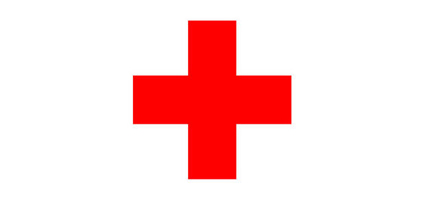Redcross Emblum
Red Cross on a white background, is the Emblem of Red Cross, recognized in 1864 as the distinctive sign for medical relief teams on the battle field. In the Russo-Turkish war the Ottoman empire used a Red Crescent in place of the Red Cross. Egypt too opted for the Red Crescent while Persia chose a Red Lion on a white background. These symbols were written and accepted into the 1929 Geneva Conventions. The IRCS adopted RED CROSS as its emblem. The National Society make use of the emblem as an indicative device in peacetime and during armed conflicts within the limits stipulated in national legislation, the regulations and its statutes only for activities consistent with the principles set out by International Federation of the Red Cross and Red Crescent.
During the General Assembly and the council of Delegates in November 2005 at Geneva, Red Crystal has been adopted as another emblem for the Red Cross Red Crescent movement.
The red cross – five, red, equal-sized squares forming a cross, resting on a white background, is one of the most recognized emblems in the world. It is also, however, one of the most poorly understood. What does it really mean?
The red cross and red crescent emblems are a universal sign of hope for people in humanitarian crises. For communities enduring the trauma of armed conflict and other situations of violence or the hardships of natural disaster, the emblems signal that help is on its way. The emblems are free of any religious, political or cultural association

ORIGIN OF THE EMBLEM
The International Red Cross and Red Crescent Movement was born on a battlefield in 1859, in Solferino, Italy. Henry Dunant, a Swiss businessman, witnessed the aftermath of a grim battle that left 40,000 dead and wounded with few military or local medical services to help them. Horrified by what he saw, Dunant organized local villagers to care for the casualties. He ensured that victims from both sides of the conflict received water, food, and rudimentary medical attention. The impact of this experience changed Dunant’s life.
Several years later, in 1863, Dunant and four other Swiss citizens organized an international conference which included delegates from fourteen countries. In addition to adopting resolutions providing for the establishment of relief societies for wounded soldiers – the future National Red Cross and later, Red Crescent Societies – the Conference delegates also adopted the red cross on a white background as a distinct symbol to identify medical personnel and their facilities.
PURPOSE
Today, the Red Cross emblem continues to be an internationally recognized symbol of protection and neutrality; used to identify military medical services as well as the people, programs and objects connected with the humanitarian activities of the International Red Cross and Red Crescent Movement.
OTHER EMBLEMS
The Red Crescent and the red crystal are equivalent symbols to the Red Cross. The three emblems have the same status under international law and following the laws of their country, a National Society is able to use one of the three emblems to indicate their work. So you will see members of the International Red Cross and Red Crescent Movement in other countries using either the red cross, red crescent or red crystal.
RESTRICTED USE OF THE EMBLEM
No organization – except the Indian Red Cross Society and the medical services of the armed forces has the right to use the Red Cross emblem in India. The red cross emblem must be readily recognized and respected around the world as a trusted symbol of protection and humanitarian aid. Its use is legislated by the Geneva Conventions Act, the Trade Marks Act and the Canadian Red Cross Society Act.

